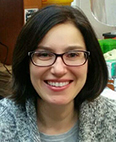
Schedule of Events
Monday, March 21, 2016
- 9:30 am - Breakfast Reception 3rd Floor Lecture Hall, Forchheimer Bldg.
- 10:00 am - 12:00 pm - Student Presentations & Awards Ceremony, 3rd Floor Lecture Hall, Forchheimer Bldg.
- 2:30 pm – 4:30 pm - Poster Session and Reception, Lubin Dining Hall
- 5:00 pm -6:00 pm - Commemorative Dinner with Past Marmur Awardees Faculty Club, Lubin Dining Hall
2016 Awardees
 Philip D. Campbell
Philip D. Campbell
"Vital roles of Kinesins in development and disease in zebrafish"
Mentor: Dr. Florence Marlow, Department of Developmental and Molecular Biology
Kinesin-1, a dimer of Kif5 proteins, was the first Kinesin motor discovered and has been implicated in numerous biological processes. Invertebrates possess a single kif5 gene, but mammals have three kif5
genes, kif5A, kif5B, and kif5C, which may support diversification of Kinesin-1-mediated biological processes. Due to their similar protein structures and functions in vitro, Kif5s are thought to act largely
redundantly. However, kif5 mouse knockouts have distinct phenotypes and human mutations in kif5A and kif5C cause distinct diseases. To study how the expanded vertebrate kif5 family contributes to development and disease, I utilized molecular genetic approaches in the zebrafish vertebrate genetic system. Using kif5B zebrafish mutants that I generated and available kif5A mutants I have identified cell-type specific roles for individual kif5s. Specifically, loss of kif5A causes a sensory-motor syndrome in zebrafish reminiscent of kif5A loss in humans. I have shown that kif5A transports mitochondria to the periphery of sensory axons and prevents axonal degeneration. Furthermore, overexpression of Kif5A
but not of other Kif5s prevents sensory neuropathy. My analysis of kif5B revealed its requirement in the egg to properly pattern the embryonic axes and to specify the germline stem cells. I have shown that perturbed patterning results from cytoskeletal and cargo localization defects in the zygote. Altogether, my work demonstrates that Kif5s play important roles in both development and disease and that while individual Kif5s share some functions, some Kif5s uniquely fulfill cell-type specific functions.
 Fanny Cazettes
Fanny Cazettes
"How the brain handles sensory uncertainty"
Mentor: Dr. Jose Luis Pena, Department of Neuroscience
Imagine hearing the siren of an ambulance while driving a car. If loud enough, it is possible to tell where the ambulance is coming from, and pull over accordingly. However, if music is playing on the radio or passengers in the car are talking, locating the direction of the siren with certainty becomes challenging. To handle the uncertainty associated with noisy and ambiguous sensory stimuli, our brain must evaluate how reliable sensory information is at any given time. However, the strategy that the brain uses to decide the appropriate behavior from noisy information is debated. We addressed this question in the sound localization system of the owl, combining neural recordings, behavioral measurements and computational modeling. We found that neurons in the owl’s brain are apriori selective to the information that is most reliable, and able to capture the degree to which this information can be trusted on a moment-by-moment basis. In light of these results, we then asked how the activity of these neurons is used to guide the owl’s orienting behavior when uncertainty varies. To do so, we recorded the neurons that command the owl’s characteristic head-turn toward sounds. We found that these neurons integrate information such that their output signals commanding the owl’s orienting behavior capture the direction of the source weighted by the uncertainty in the sensory cues. Therefore our work sheds light on the code used by the brain to capture sensory uncertainty and command behavior efficiently.
 Veronika Miskolci
Veronika Miskolci
"Optical tools to study the isoform-specific roles of small GTPases in immune cells"
Mentor: Dr. Dianne Cox & Dr. Louis Hodgson, Department of Anatomy and Structural Biology
Despite the 92% homology between Rac1 and Rac2, these isoforms play non-redundant roles in hematopoietic cells. To study the isoform-specific dynamics of Rac isoforms in live cells, we optimized and developed isoform-specific, genetically-encoded, single-chain FRET-based biosensors for Rac1 and Rac2, respectively. In addition, we employed several strategies, including selective promoter usage and our recently reported “synonymous modification” to achieve stable, full-length expression of biosensor in hematopoietic cells, critical for proper biosensor readout and data interpretation. We functionally validated these biosensors in a murine monocyte-macrophage subline of RAW 264.7 cells in the context of forming actin-rich protrusions. Rac1 and Rac2 had similar activation kinetics yet distinct spatial distributions in response to fMLP; active Rac1 localized to the cell periphery while active Rac2 broadly localized in the perinuclear region. Morphodynamic analysis of Rac1, Rac2 and Cdc42 activities during the extension of random protrusions revealed that Rac2 played a leading role in the generation of random protrusions; Rac2 strongly activated first in regions distal from the leading edge, followed by the activation of Rac1, Rac2 and Cdc42 immediately behind the leading edge. Overall, partnering the use of optimized, isoform-specific biosensors should be valuable for interrogating the coordination of Rho GTPase activities in living cells.
 Dachuan Zhang
Dachuan Zhang
"Neutrophil aging is regulated by the microbiome"
Mentor: Dr. Paul Frenette, Department of Cell Biology
Blood polymorphonuclear neutrophils provide immune protection against pathogens but also may promote tissue injury in inflammatory diseases. Although neutrophils are generally considered as a relatively homogeneous population, evidence for heterogeneity is emerging. Under steady-state conditions, neutrophil heterogeneity may arise from ageing and the replenishment by newly released neutrophils from the bone marrow. Aged neutrophils up-regulate CXCR4, a receptor allowing their clearance in the bone marrow, with feedback inhibition of neutrophil production via the IL17/G-CSF axis, and rhythmic modulation of the haematopoietic stem cell niche. The aged subset also expresses low levels of L-selectin (CD62L). Previous studies have suggested that in vitro-aged neutrophils exhibit impaired migration and reduced pro-inflammatory properties. Here, we show using in vivo ageing analyses that the neutrophil pro-inflammatory activity correlates positively with their ageing in the circulation. Aged neutrophils represent an overly active subset exhibiting enhanced αMβ2 integrin (Mac-1) activation and neutrophil extracellular trap (NET) formation under inflammatory conditions. Neutrophil ageing is driven by the microbiota via Toll-like receptors (TLRs)- and myeloid differentiation factor 88 (Myd88)-mediated signaling pathways. Depletion of the microbiota significantly reduces the number of circulating aged neutrophils and dramatically improves the pathogenesis and inflammation-related organ damage in models of sickle cell disease or endotoxin-induced septic shock. These results thus identify an unprecedented role for the microbiota in regulating a disease-promoting neutrophil subset.
More about the Julius Marmur Symposium